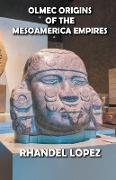Olmec Origins of the Mesoamerica Empires
BücherAngebote / Angebote:
The Olmec: An Introduction
Generally, the Olmec people are regarded as Mexico's first significant civilization, they are also considered the people from whom all subsequent Mesoamerican cultures developed. In fact, the term Olmec is thought to have been coined by the Aztecs since Olmec means "people of rubber, " which referred to those living in the Land of the Olmecs from which rubber was obtained. The Olmec culture may be best known for its colossal heads and mammoth basalt heads dressed in helmet-like headdresses found throughout Olmec habitation sites.
Olmec populations thrived during North America's Prehistoric Indian Formative period between 1700 and 400 B.C. on Mexico's Gulf Coast in tropical lowlands (in contemporary Veracruz and Tabasco). They continued to contribute directly to Mesoamerican culture well into the third millennium A.D. Mesoamerican scholars divided the Formative period into the Preclassic (Olmec period), Classic (Maya period), and Postclassic (Toltec and Aztec periods).
Agrarian skills enabled the Olmecs to remain robust and influential for millennia. In addition to growing large quantities of corn/maize, squash, and other plant foods, they built sumptuous monuments and ceremonial centers to further promote their cultural identity. They set the stage for subsequent societies like the Maya, Zapotec, Teotihuacan, Toltec, Mixtec, and Aztec to emulate with their pyramids, open plazas, ballgames, and perhaps even human sacrifice centers. According to some scholars, they also contributed to the cultural development of Native American groups in the United States, Central America, and South America.
The religious and cultural structures established by the Olmecs survived for more than 3, 000 years, and without the arrival of the Spanish conquistadors, they would have stayed even longer.
Folgt in ca. 5 Arbeitstagen

